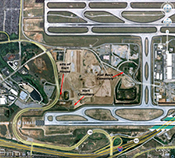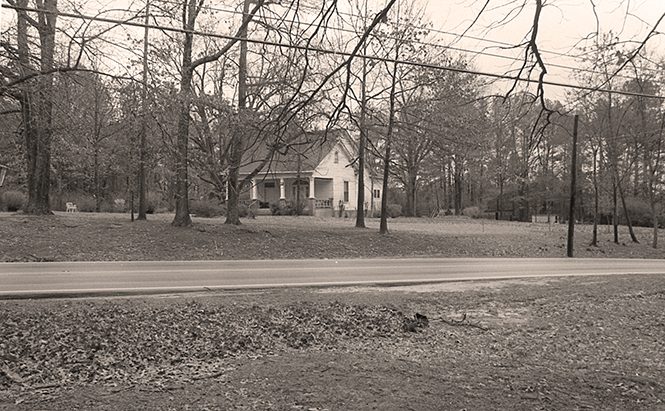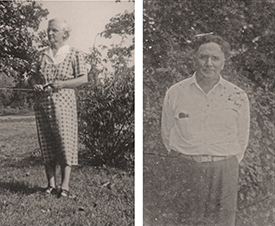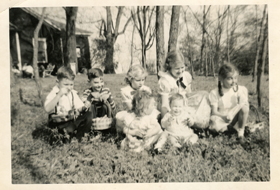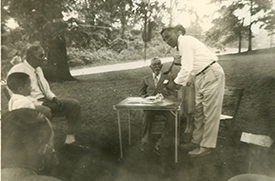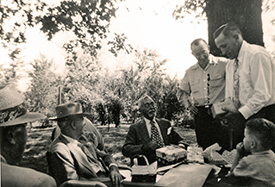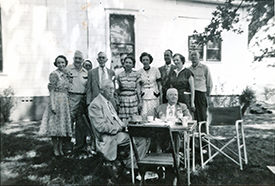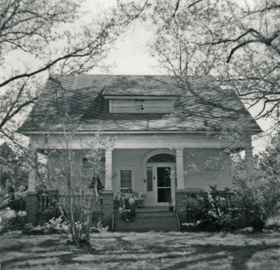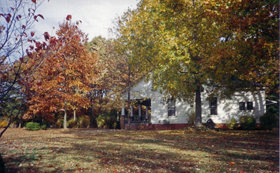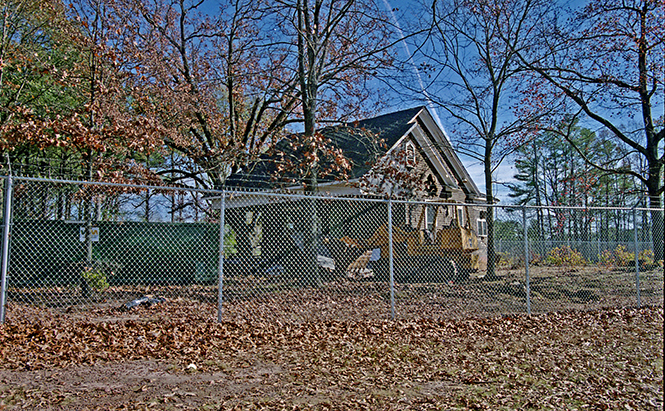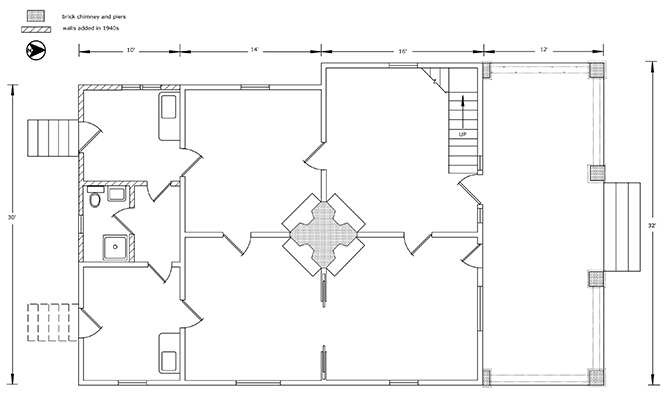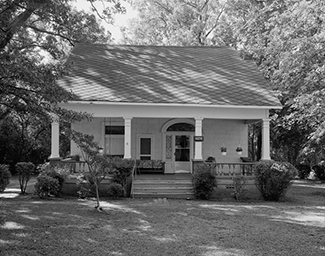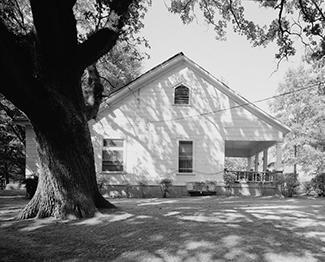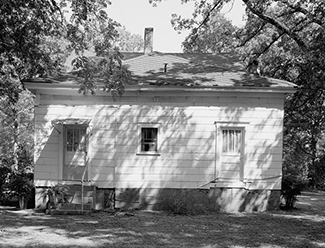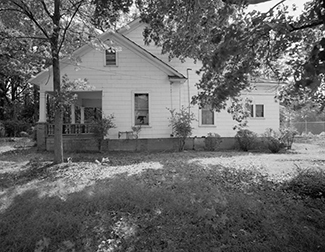The house was constructed by Ernest Emerson Hart (1892-1945) and Jewell May Lee (1895-1990) in 1915 on or near the site of the log house that his grandfather John J. Hart (1816-1898) built in the 1840s. The house sat on a 2.39-acre tract that was part of the property purchased by John Hart in 1849. Along with an approximately 3.5-acre tract to the east and a one-acre tract to the south, the property was owned by John Hart's descendants until the late 1990s. Several of John Hart's children built houses in the area, including Ernest's father, Josiah Meredith Hart (1857-1957), who built a house about 1895 on Sullivan Road just east of W. Fayetteville Road. It was demolished in the late 1970s. Demolition of the Oscar Estes Hart (1875-1940) house in 1989 left the Ernest Hart House as the last historic residence remaining between the airport and I-285.
Ernest and Jewell Hart's five children each inherited a portion of the land that Ernest himself had inherited from his own parents. Four of them built houses in the fifteen years after World War II and, for most of the rest of the twentieth century, continued a third generation of John Hart's descendants still living on his 1849 homestead.
The Hart Family Cemetery was located directly south of the intersection of Liberty Street and Honeysuckle Lane, about a quarter mile southeast of the Ernest Hart house. Its oldest graves are those of Ellender Brown Hart (1822-1860), John J. Hart's first wife, and William Jasper Hart (1844-1864), John and Ellender Hart's oldest son. Less than half mile to the northeast of the Hart house is the Flat Rock Baptist Church cemetery. The church was organized in the home of John J. Hart in 1872 and a building constructed a few years later on land donated by John Hart's brother-in-law William Dodson (1808-1877). The congregation no longer exists, and the old church building (ca. 1895, remodeled 1946, 1956) was torn down in March 1996. The cemetery remains intact, and many of John Hart's descendants are buried there.
|
Figure 1. View to southeast of Ernest Hart House in 1991. |
|
Figure 6. Jewell and Ernest Hart, ca. 1940. |
|
Figure 7. Jewell and Ernest Hart's grandchildren in the yard west of the house, 1950. |
|
Figure 8. Josiah Hart's birthday, 1952, in yard of Ernest and Jewells house. |
|
Figure 9. Josiah Hart's birthday, 1953, in yard of Ernest and Jewells house. |
Ernest Emerson Hart (1892-1945) and Jewell May Lee (1894-1989)
Ernest Emerson Hart was born on 27 February 1892, the seventh of eleven children of Josiah Hart (1857-1957) and Louisa Graham Hart (1856-1927). He grew up working on his parent's farm in northwestern Clayton County. On Christmas Day 1913, he married Jewell May Lee (1894-1989), daughter of Ipson Lee (1862-1930) and Tommie Eidson Lee (1866-1957). The Lee farm was on the Newnan Wagon Road, now Washington Road, just north of Camp Creek, just three air miles northwest of the Harts.
They first rented a house off Riverdale Road, a short distance northwest of his parents’ house, and he continued to work on the family farm, which was then doing a thriving business growing and supplying produce for the market in Atlanta. Their first child, Ernest Maurice, was born on 14 September 1914, by which time they may already have begun planning their own home.
Why they chose to build on or near the site of his grandparent’s house is not known, but the home site with its old oak trees and a view of Sullivan’s Creek was a natural choice even without the family associations. Since Ernest was no builder, he hired his aunt Susie's husband, James Monroe Phillips, a carpenter by trade, to build the house. For the masonry work, including the massive central chimney that served all four fireplaces in the house, he hired Jewell's brother-in-law Benjamin F. Tankersly (1889-1925), who had married Jewell’s older sister Clemar in 1911. Ernest and Jewell’s new house was probably complete and they had moved in by the time their second child, Ruby Hazel, was born on Valentine’s Day 1914.
Ernest continued to work on the family farm for a few more years, but he must have already developed an interest in mechanics and short-wave radio even though he still listed his occupation as farmer in the census of 1920. By then another daughter, Ruth, had been born;
two more, Iris and Melba, followed in the early 1920s. Like the rest of his siblings, except for his oldest brother, O. E., who continued to work the family’s truck farm, Ernest had turned away from farming and was working as an automobile mechanic. In the late 1920s and the 1930s, he was employed by Mavis Bottling Company and, for a longer period, by Barrett Food Company in Atlanta.
|
Figure 10. Josiah Hart, his children, and Iris, 1953, behind Ernest and Jewell's house. |
|
Figure 11. Hart House in 1965. |
|
Figure 12. Hart House about 1980. (photo by Greg Dailey) |
Ernest and Jewell’s daughter Ruth married Luther Creel in 1937 and gave them their first grandchild, Manya, in 1938. By then, Ernest had turned to the installation of well pumps for his livelihood. He was the Atlanta distributor for Dayton Water Systems well pumps which he generally installed himself, often with the help of his son. He still worked often as a mechanic and during World War II spent a year in San Juan, Puerto Rico, as a civilian mechanic with the Army.
As the war drew to a close, Ernest Hart was back home, selling and installing well pumps. On 14 May 1945, he was installing a pump at a residence on Belle Isle Road in North Atlanta when he suffered a fatal heart attack. He was buried two days later at College Park Cemetery.
Jewell Hart lived on in the house after her husband’s death. Ernest had installed a generator for electric lights even before the REA brought the power lines in 1937. A pump was installed to the spring, eliminating the laborious trek down the hill and back up two or three times a day. There was even an in-door bathroom after 1942. Iris married in 1941 and moved away, but when Melba married in 1946, she and her husband Lawrence Dailey moved in with Jewell. Over the next few years, they completely renovated the house, creating a duplex with Jewell occupying the three rooms on the east side and the Daileys the three on the west.
The Daileys moved into their own home just up the road in the late 1950s, and Jewell once again had the house to herself. In the 1960s, the Daileys built a new house just southwest of the Hart House and because of that, Jewell was able to live in her own house for the rest of her life.
Beginning in the early 1950s, the large oaks which had shaded John Hart's house before the Civil War began to fall, and by the time the house was razed in 2001, most of them were gone. The huge red oak on the east side of the house survived as did an ancient post oak in the triangle at the driveway entrance and the walnut at the back door which was said to have been planted by John Hart's daughter Susie just after the Civil War. In 1974, one of the large oaks that shaded the west side of the house house blew down in a storm, demolishing the northwest quadrant of the front shed of the roof, including half of the porch below. Two brick piers and their wooden box columns had to be reconstructed as did much of the front half of the roof, although without the original, windowless, shed-roofed dormer on the front shed of the roof. All four of the balustrades were salvaged, but one of the four was subsequently stolen, so that the balustrades from the remaining three were spaced over four reconstructed balustrades.
Jewell Hart died on 3 November 1989 and was buried next to Ernest in the College Park Cemetery. The house remained mostly unoccupied after her death, although Melba and Lawrence continued to maintain the property as they always had.
The Airport
Plans for a fifth runway at Hartsfield-Jackson International Airport were already underway before Jewell's death. Originally developed in the 1920s on the site of an abandoned automobile race track, Atlanta's airport was the nation's third-busiest as early as 1930. By 1957, it was the nation's busiest airport and expanding rapidly. A new terminal opened in 1961, but it was necessary to begin construction of a new midfield terminal in barely fifteen years later. In 1982, a fourth runway was added, and ten years after that, the Federal Aviation Administration began an environmental impact statement (EIS), required by the National Environmental Policy Act, for construction of a fifth runway.
In October 1992, required archeological testing was conducted on the Ernest Hart House site and the nearby Hart family cemetery as well as three prehistoric sites that had been located in another part of the runway's impact area. Conducted by archeologists from Garrow and Associates, the work attempted, unsuccessfully, to locate the exact site of John Hart's original log house, which the family always believed was more or less where Ernest Hart built his house in 1915. However, around that time, a number of large stones were located about seventy-five feet south of the Hart House. Most of these were of a type that were typically used for stacked-stone piers upon which to build log houses in the early years of white settlement of the area. One, however, was much larger than the rest, over two feet in diameter and three or four inches thick. What were clearly man-made grooves had been worked into the stone in a manner to facilitate tying chains or ropes so that it could be dragged some distance, probably from the creek at the foot of the hill. This may very well have served as the door step for John and Ellender Hart's log house. Most of these stones as well as the smaller stones that had been set upright as a border to the triangular bed at the old driveway entrance were removed to 394 Sinclair Avenue in Inman Park, Atlanta, where they were used for landscaping the rear yard.
The EIS included not only natural resources but historic and archeological resources as well, and a number of such resources were identified in the study area, which included most of the area betweeen the existing airport and I-285 as well as a large area outside I-285. The Ernest Hart house had already been identified in a 1977 state survey as a property that was potentially eligible for listing in the National Register of Historic Places, and in 1994, the FAA signed a memorandum of agreement with the State Historic Preservation Office stipulating that the house would be recorded by the Historic American Building Survey prior to its proposed demolition. That agreement also specified that preservation plans would be developed for both Flat Rock Cemetery and the Hart family cemetery.
Construction of the fifth runway began in May 2001, and by then the Hart House had been photographed and documented by the Historic American Building Survey, as required by the memorandum of agreement. As stipulated, both cemeteries were preserved in situ. Doors, mantels, and leaded-glass windows from the Hart House were salvaged by Melba and Lawrence before the it was finally demolished in December 2001.
|
Figure 19. View southeast of Hart House in December 2001 after the asbestos siding and front porch columns had been removed. |
|
Figure 20. Plan of Hart House. (T. Jones, 2001) |
